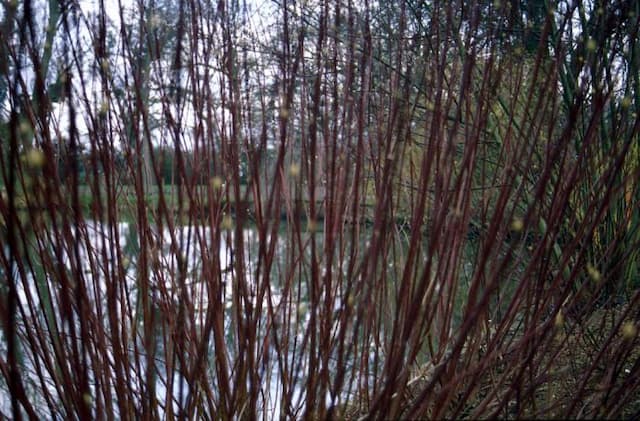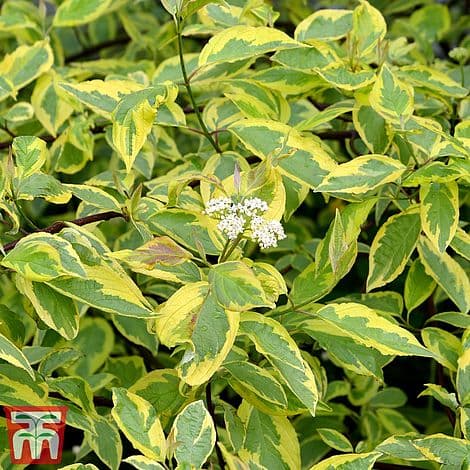Kousa dogwood Cornus kousa 'Beni-fuji'











ABOUT
The Cornus kousa 'Beni-fuji', commonly known as the Kousa Dogwood, is a visually appealing plant characterized by a stunning display of ornamental features. It is especially known for its flowers, which bloom profusely in late spring to early summer. These are not true flowers but rather modified leaves known as bracts. The bracts are a deep pink to red color, which surround a small, inconspicuous cluster of yellowish-green true flowers. As the season progresses, the bracts fade to lighter shades of pink. The foliage of the Kousa Dogwood 'Beni-fuji' is also notable. The leaves are oval to lance-shaped with pointed tips and are a rich, glossy green that further accentuates the visual impact of the pink bracts. The leaf arrangement is opposite, which creates a balanced and symmetrical presence on the branches. In the fall, the leaves of the Kousa Dogwood 'Beni-fuji' exhibit a transformation in color, displaying a palette of autumnal hues such as vibrant reds, oranges, and yellows. This adds another layer of ornamental value to the plant as seasons change. The plant also produces berry-like fruits after the flowering period. These are globular and initially a greenish color, maturing to a bright red or pinkish-red in late summer to fall. The fruits are visually attractive and can attract birds and other wildlife to the garden. The bark of the Kousa Dogwood 'Beni-fuji' is yet another distinguishing feature. It exfoliates with age, revealing a mottled pattern of tan, grey, and brown that provides year-round textural and visual interest. The exfoliating bark adds to the mature character of the plant, giving it a striking appearance even in the winter months when the leaves have fallen. Overall, the Cornus kousa 'Beni-fuji' is known for its beautiful pink bracts, vibrant fall foliage, attractive fruit, and exfoliating bark, making it a highly decorative plant with multi-seasonal interest.
About this plant
 Names
NamesFamily
Cornaceae
Synonyms
Beni-fuji Kousa Dogwood, Pink Kousa Dogwood, Red Japanese Dogwood
Common names
Cornus kousa 'Beni-fuji'.
 Toxicity
ToxicityTo humans
Kousa dogwood, generally considered to be non-toxic to humans, is widely regarded as safe. In fact, the fruit of Kousa dogwood is sometimes eaten raw or used to make wine or jelly. However, it is always recommended to be cautious when trying new plants, as individual allergic reactions or sensitivities could occur.
To pets
Kousa dogwood is also considered to have a low level of toxicity for pets such as dogs and cats, and it is not commonly listed as a toxic plant for domestic animals. Therefore, ingestion of this plant doesn't typically result in poisoning or severe health complications. However, as with humans, individual pets may have sensitivities or allergic reactions, and consumption of non-food items can sometimes cause gastrointestinal upset.
 Characteristics
CharacteristicsLife cycle
Perennials
Foliage type
Deciduous
Color of leaves
Green
Flower color
Pink
Height
15 feet (4.57 meters)
Spread
15 feet (4.57 meters)
Plant type
Tree
Hardiness zones
5
Native area
Asia
Benefits
 General Benefits
General Benefits- Ornamental Value: The Kousa dogwood 'Beni-fuji' is known for its showy pink flowers that enhance the aesthetic appeal of gardens and landscapes.
- Wildlife Attraction: Its fruits are attractive to birds and other wildlife, which can help support biodiversity.
- Seasonal Interest: It provides year-round interest with flowers in spring, fruits in summer, colorful foliage in autumn, and exfoliating bark in winter.
- Drought Tolerance: Once established, the plant is relatively drought-tolerant, requiring minimal watering under normal conditions.
- Pest Resistance: It is resistant to many common pests, reducing the need for chemical interventions.
- Disease Resistance: The Kousa dogwood is more resistant to dogwood anthracnose and other diseases compared to other dogwood species.
- Adaptability: This plant adapts well to a variety of soils, although it prefers well-drained, acidic soils.
- Urban Tolerant: The Kousa dogwood can thrive in urban settings, tolerating pollution and compacted soils better than many other trees.
- Low Maintenance: It requires minimal pruning and upkeep, making it a suitable choice for both novice and expert gardeners.
 Medical Properties
Medical PropertiesThis plant is not used for medical purposes.
 Air-purifying Qualities
Air-purifying QualitiesThis plant is not specifically known for air purifying qualities.
 Other Uses
Other Uses- Edible fruit production: The raspberry-like fruit of Cornus kousa can be eaten fresh, used in pies, or made into wine for culinary purposes.
- Dye source: The bark and leaves can be used to create natural dyes for textiles and crafts.
- Woodworking: The wood of Cornus kousa is hard and dense, making it suitable for small woodworking projects like tool handles and fine crafts.
- Bonsai cultivation: Because of its attractive foliage and structure, Cornus kousa can be trained as a bonsai specimen.
- Wildlife habitat: The tree provides food and shelter for various bird species, as well as food for pollinators when in bloom.
- Ink production: The fruit has been historically used to make a form of ink.
- Folk crafts: The tree's branches and leaves can be incorporated into traditional folk art and craft projects.
- Educational tool: Cornus kousa can be used in schools and educational programs to teach students about plant biology and horticulture.
- Cultural events: In some cultures, the flowers of the Kousa dogwood are used in festivals or artistic displays to celebrate the seasons.
- Photography subject: The tree's striking appearance, especially during bloom, makes it an excellent subject for photography and botanical illustration.
Interesting Facts
 Feng Shui
Feng ShuiThe Kousa dogwood is not used in Feng Shui practice.
 Zodiac Sign Compitability
Zodiac Sign CompitabilityThe Kousa dogwood is not used in astrology practice.
 Plant Symbolism
Plant Symbolism- Resilience and Strength: The Kousa dogwood, being a hardy and disease-resistant plant, often symbolizes resilience and the ability to withstand difficulties.
- New Beginnings: As dogwoods typically flower in the spring, they are associated with renewal and the start of new phases in life.
- Purity and Innocence: The white, petal-like bracts of the Kousa dogwood signify purity and innocence, reminiscent of white laces and traditional white garb in various cultures.
- Endurance: The tree's ability to endure various seasons and bloom each year makes it a symbol of endurance and the continuity of life.
- Love and Affection: In Victorian flower language, dogwoods are connected to affection and can convey love, particularly the softer, more enduring forms of love.
- Christian Symbolism: The shape of the dogwood's flowers, which resemble a cross, along with the markings on the petals, have led to it being linked with Christianity and the story of Jesus' crucifixion.
 Water
WaterFor the Kousa Dogwood, it is important to maintain consistent moisture, especially during hot, dry periods. Water the tree deeply with about 1-2 gallons of water per week, increasing the amount during periods of drought or extreme heat. During the growing season, in spring and summer, monitor soil moisture regularly and adjust watering as necessary to ensure the soil doesn't become waterlogged or completely dry out. In the winter, reduce watering as the tree's growth slows down and it requires less moisture.
 Light
LightKousa Dogwood thrives in conditions where it receives full sun to partial shade. Ideally, aim for a spot that receives at least 4-6 hours of direct sunlight per day. If planted in too much shade, the tree may not bloom as prolifically, so it's important to find a balance where it can get adequate light while being protected from the harshest afternoon sun.
 Temperature
TemperatureThe Kousa Dogwood is hardy and can tolerate a range of temperatures, with an ideal growing range between 60°F and 75°F. It can survive minimum temperatures down to -10°F and maximum temperatures well into the 90s°F. However, extended periods of extreme cold or heat may stress the tree, so providing a mulch layer around the base can help to regulate soil temperature and moisture.
 Pruning
PruningPruning the Kousa Dogwood is beneficial for shape maintenance and to remove any damaged or diseased branches, promoting healthy growth and airflow. Prune in late winter or early spring before new growth starts, cutting just above a bud facing the outside of the plant to encourage outward growth. It is not necessary to prune every year, but a periodic check to remove any problematic branches is advisable.
 Cleaning
CleaningAs needed
 Soil
SoilThe Kousa dogwood 'Beni-fuji' thrives in well-draining, loamy soil amended with compost or well-rotted organic matter. It prefers a slightly acidic to neutral pH, ranging from 5.5 to 7.0. To create the best soil mix, combine two parts garden soil, one part peat moss or pine bark, and one part perlite or coarse sand for drainage.
 Repotting
RepottingKousa dogwoods, including the 'Beni-fuji' variety, being larger landscape trees, are not commonly repotted. Instead, they should be planted in a permanent outdoor location where they can have space to mature.
 Humidity & Misting
Humidity & MistingKousa dogwood 'Beni-fuji' prefers moderate humidity levels typical of its native outdoor environment. It does not require specific humidity conditions when grown in the landscape and is adaptable to the ambient humidity.
 Suitable locations
Suitable locationsIndoor
Not ideal for indoor growing; needs full sun, well-draining soil.
Outdoor
Plant in full sun to partial shade, mulch, and water regularly.
Hardiness zone
5-8 USDA.
 Life cycle
Life cycleCornus kousa 'Beni-fuji', commonly known as Kousa dogwood, begins its lifecycle as a dormant seed which requires cold stratification to germinate. Upon sprouting, the seedling develops into a young plant, exhibiting rapid vegetative growth, producing leaves and a characteristic woody stem. As the plant matures, it develops a more extensive root system and branches, forming a small tree structure. Flowering usually occurs in late spring to early summer, showcasing white to pink bracts surrounding small greenish-yellow flowers, which are followed by the production of berry-like fruit that ripens to a pinkish-red in late summer to fall. These fruits contain seeds that, once dispersed, can initiate the next generation. The Kousa dogwood may also undergo periods of dormancy throughout its life, particularly in colder climates during the winter months.
 Propogation
PropogationPropogation time
Late winter-early spring
Propogation: The Kousa dogwood (Cornus kousa 'Beni-fuji') is commonly propagated through seed collection and sowing, but this cultivar is often best replicated through softwood cuttings to preserve its specific characteristics. The softwood cuttings are usually taken in late spring to early summer when the new growth is just beginning to harden but is still pliable. Cuttings should be about 4 to 6 inches (10 to 15 cm) in length and include at least two sets of leaves at the top. The lower leaves are removed, and the cut end can be dipped in a rooting hormone to encourage root growth. The prepared cutting is then placed in a pot filled with a moistened mixture of perlite and peat moss, ensuring good contact between the cutting and growing medium. The pot is then placed in a warm area with indirect light and covered with a plastic bag or placed in a propagation chamber to maintain high humidity. Roots typically develop within 4 to 8 weeks, after which the new plant can be gradually acclimatized to less humid conditions and eventually transplanted outdoors.









